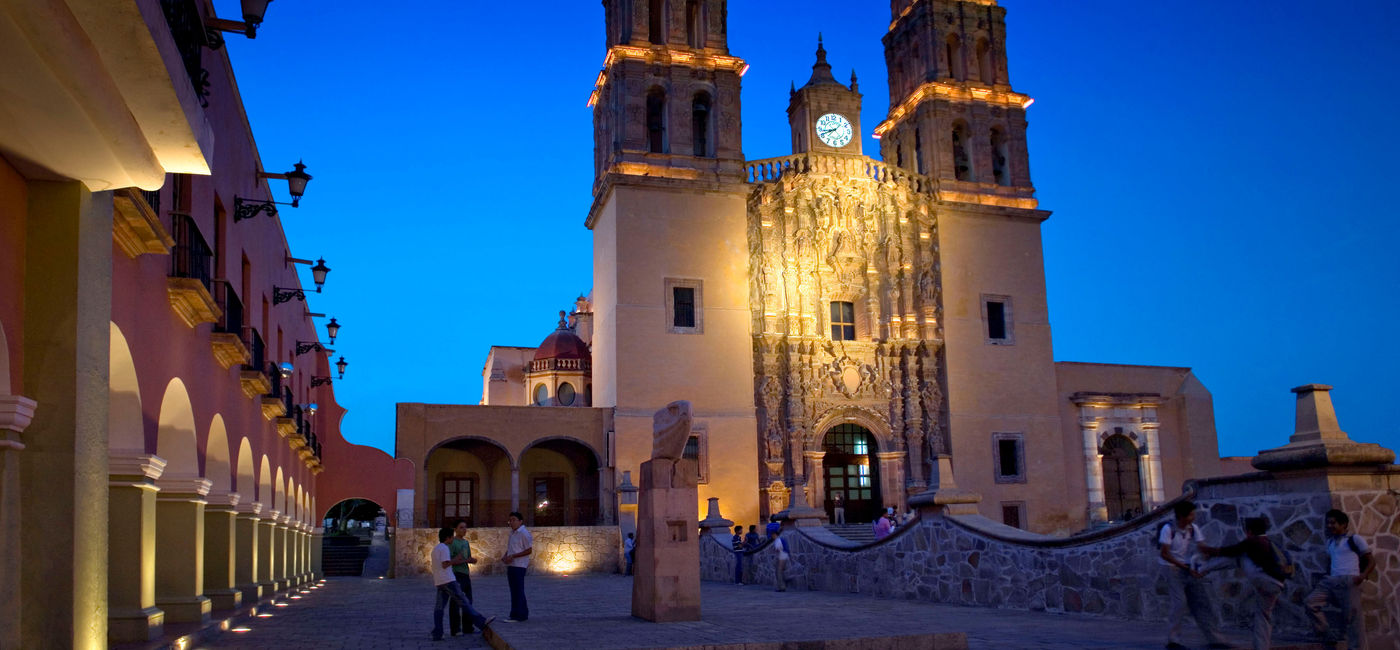
The state of Guanajuato always feels touched by magic, but nowhere is this more true than in its six Magical Towns. Mexico’s term “Magical Towns” is a government designation given to towns and villages that exemplify aspects of tradition, culture, heritage, cuisine, history, or art. The state of Guanajuato is blessed with six of these special spots.
Dolores Hidalgo C.I.N.
The town of Dolores Hidalgo is much more than a beautiful town in Guanajuato. It is known as the “Cradle of Independence” in Mexico because it is the place where hero Miguel Hidalgo delivered the “Cry for Independence” for Mexico from Spain.
Today, visitors to Dolores Hidalgo can stroll through time, visiting the various historic points from City Hall and the Visitors House to the Independence Museum and the House Museum of Don Miguel Hidalgo. Dolores Hidalgo is also famous for its traditional majolica tiles, which are typical of Spanish architecture in Mexico.
One of the top attractions in Dolores Hidalgo is the Parroquia de Nuestra Señora de Dolores. This parish has a carved pink-stone facade, and it was from here on September 16, 1810, that Father Miguel Hidalgo rang the bells and expelled the famous “Cry of Independence” as a call to rebel against the Spanish.
Visitors and locals delight in the unique local ice cream or “nieve” found in the town’s main plaza, offering a peculiar assortment of flavors ranging from mole or pork rind to “garambullo,” an endemic cactus fruit. Foodies should also visit El Llanito community, a great place to sample the Otomí cuisine.
Dolores Hidalgo is also the birthplace of one of the greatest singer and songwriters of Mexican folk music, José Alfredo Jiménez whose “El Rey” is a key Mexican song. Mausoleum, located on the outskirts of the town is a stomping ground for his fans.
The artisanal Talavera pottery and Mayólica ceramics made in town stand out for their luminous colors. These tin-glazed ceramics are crafted using a centuries-old traditional technique preserved through time in the hands of local artisans.
For wine enthusiasts: visit the Wine Museum, the second of its kind to be opened in Mexico or take a walk through one of the many beautiful vineyards in the region.
Mineral de Pozos
Much of Guanajuato’s history is rooted in mining, particularly gold, copper, and zinc. The town of Mineral de Pozos was once the mining capital of the region. In the late 19th century, it housed approximately 300 mines, but none was more important than Santa Brigida. Today, this historic “Ghost Town” is full of life through its magic and mysticism.
Visitors to Mineral de Pozos can wander the relics of 19th- and early 20th-century buildings, as well as plunge down into an old mine more than 200 meters below the earth’s surface.
Among the top attractions in Mineral de Pozos is the 18th-century Parish of San Pedro, just in front of the beautiful Juarez Garden. Around the garden are lovely art galleries, boutiques, and craft stores.
But Mineral de Pozos is also a haven for outdoor adventure, from biking and horseback riding to hiking, rappelling, or simply walking through the wildflower-strewn fields.
Salvatierra
Surrounded by lush, green valleys and fed by the Lerma River, Salvatierra traces its roots to the pre-Hispanic Chipicuaro and Chichimeca cultures who settled in the area centuries ago.
Of course, the Spanish did eventually settle here as well, bringin with them their architectural vision, creating works like the Nuestra Señora de la Luz church and the Templo de San Francisco. But the first church to be built in town was the Temple and Convent of Our Lady of Carmen, which dates back to 1646.
The town’s Spanish heritage is a big part of its personality and tourism attraction with two emblematic traditions in Salvatierra tracing their roots to the colonial era: the Paseo de las Manolas Parade held every year on February 2, and the famed Marquesada Festival, a fusion of music, folk dance and the bullfighting performance art.
In the surrounding area, Salvatierra has more than 300 haciendas that represent much of the historical and cultural heritage of Guanajuato. Some haciendas to note are San Jose del Carmen, Santo Tomas de Guatzindeo, and San Nicolas de los Agustinos.
Yuriria
Yuriria, located in southern Guanajuato, carries with it a huge slice of history. The city is home to one of the oldest Spanish structures in Mexico and is best known for the 16th-century Ex-Convento of San Pedro and San Pablo. Reminiscent of a medieval castle, the building houses a museum full of religious objects. The convent overlooks the Yuriria Lagoon, which was the first hydraulic project of the vice royal era in Mexico, as well.
Visitors to Yuriria marvel at the structures’ Renaissance facade, its cloisters, and gardens. For the best view, consider a boat ride on the lake to visit the small islands.
Comonfort
Have you ever seen a traditional “molcajete”? These basalt rock mortar bowls have been used for centuries in Mexico as a cooking tool. Today, they are used for serving bubbling meat and fish dishes, preparing spices, or serving guacamole. What makes them so unique is that they are typically carved from a single piece of rock. The Magical Town of Comonfort is known for its molcajateros artisans, who mold the stones to create these iconic Mexican kitchen pieces.
Among the top attractions in Comonfort are the historic Parish of San Francisco, the archaeological zone of Orduna de Abajo, the San Miguel Vineyard, and the Chapels of Indians, which dates back to the 16th century.
One of the main reasons Comonfort became a Magical Town is its incredible preservation of culture, including native Otomí cuisine, the Chicimeca Gamares folk dance and it famous ceremonial tortillas, a peculiar culinary art consisting in stamping corn tortillas using wooden seals of various shapes and imagery with a purple pigment made from a plant known as ‘muicle’ or Mexican honeysuckle. These decorated tortillas represent an offering of gratitude for a plentiful harvest amid the religious festivities that take place in town.
Wine drinkers will enjoy a visit to the almost 150 acres of what is “Viñedos San Miguel”. With more than 140,000 vines, it is the largest vineyard in the state of Guanajuato. Its winery, with an area of 2 square acres has a tasting room, restaurant, area for events, and a gourmet store.
The town of Comonfort is also home to the archaeological zone of Cerro de los Remedios, an enclave of the Laja Bajío area, it was in pre-Hispanic times, a ceremonial center that has pyramidal bases, ceremonial structures, patios, terraces and a large central square, in which, in the past, large crowds gathered. Today it is part of the state’s initiative to rescue the area and at some point provide access to visitors.
Jalpa de Canovas
One of the most historic Spanish towns in Mexico, Jalpa de Canovas traces its roots back to 1542, when the lands were granted to Don Juan Villasenor to construct a hacienda. Four hundred years later, the hacienda was one of the most thriving haciendas in the country. Today, visitors can step back in time and visit what remains of the estate, including its gardens, the grain mill rooms and the historic aqueduct.
Much of the town’s historic and cultural relevance is owed to the exceptionally fertile soil in the area which has fostered the emergence of prominent cattle and vegetable farms and a famous walnut tree plantation.
Prime examples of the local cuisine are: figs, cactus, walnut mole (sweet and spicy chocolate based sauce), pickled pigs feet, enchiladas with dried beef, and ‘caldo de zorra’ (a broth made with sour prickly pear).
The town’s “Jalpa Region” is part of Guanajuato’s Wine Route and its vineyards go back to the Cristero era. Visitors can walk to town from the vines to the middle of the town where the beautiful Church of the Señor de la Misericordia, which was constructed in the early 20th century, is known for its bright, decorative stained-glass windows and murals.
One very unique activity in Jalpa de Canovas is the festivity of the Judea which has been performed here for almost 150 years during Holy Week. It is a staging of the passage from the Passion of Christ where Judas Iscariot helps the Jews to apprehend Jesus. Judas would later be hanged for his betrayal.







